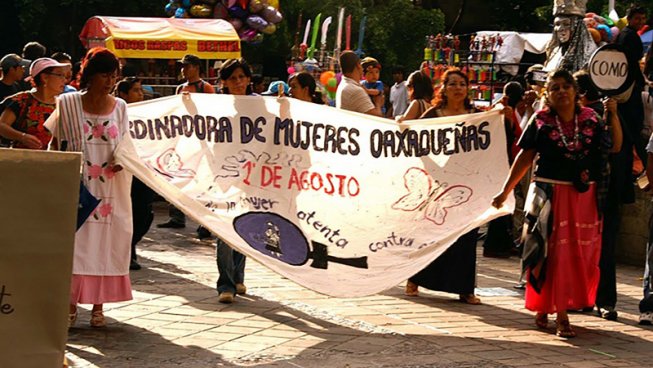By Sari Albornoz
Introduction

Colectivo Mujer Nueva is a feminist women’s collective in Oaxaca, Mexico that carries out a variety of projects intended to protest existing power structures and build community power. The collective was born out of Oaxaca’s 2006 popular movement, which emerged when the Oaxacan state government rejected teachers’ union-led protests to demand improved working conditions and removed demonstrators occupying Oaxaca city’s central plaza (Poma & Gravante, 2019, p. 240). Thousands of women marched in the streets and a group of women took over and occupied the state-run television station (Poma & Gravante, 2019, p. 241). Afterward, a group of women who participated in the movement formed Colectivo Mujer Nueva (Poma & Gravante, 2019, p. 241). The Colectivo, which now includes about 20 members, facilitates diverse projects ranging from non-violent direct-action protests to a Tianguis Popular Mujer Nueva (Mujer Nueva Community Market) that features healthy foods, traditional medicines, and body care products created by collective members (Jiménez, 2016). The group also organizes capacity-building workshops about domestic violence and a traveling theater that addresses topics such as machismo and abortion (Poma & Gravante, 2019, p. 241-2). The group manages an active Facebook page and creates posters about the Tianguis Popular and other community events.
Analysis
The perspective of visceral geography as described by Sweet and Ortiz Escalante (2014) illuminates how Colectivo Mujer Nueva has been empowering for its members. Visceral geography looks to the scale of the body and its sensory and emotional experiences for insights into the safety of social spaces, as well as “broader political, social, and economic concerns including the structural side of violence and economic inequity” (Sweet, Elizabeth L. & Ortiz Escalante, 2014, p. 1828), including the socially-constructed public-private divide which makes it difficult to combat domestic violence. When the women participated in the Marcha de las Cacerolas (March of the Pans) on August 1st, 2006, they created a shared sensory experience (Sweet, Elizabeth L. & Ortiz Escalante, 2014) by using their bodies to express anger and indignation. They also rejected sequestration into the private sphere by collectively claiming space in the streets of Oaxaca City. In their current work, the organizers of Colectivo Mujer Nueva continue to claim and “repurpose” space for shared sensory experiences, creating safe environments for women to share, process, and release their emotions about their experiences with violence.

By claiming “invented” spaces of citizenship, Colectivo Mujer Nueva’s work also constitutes a form of insurgent planning as defined by Miraftab (2009) and Shrestha and Aranya (2015). First, through their integral role in the popular resistance, these organizers resisted the neoliberal policies of the Oaxacan government, occupying the central plaza of Oaxaca City with encampments, spray-painting buildings with demands that the governor resign, and marching through the streets (Garza Zepeda, 2016). Second, the Colectivo women “invented” (Miraftab, 2009) space by asserting their right to participate in public protests as women in a patriarchal society (Poma & Gravante, 2019). A group of women (some of whom went on to form the Colectivo) took over the state-run television station and occupied it for 21 days, creating and broadcasting content in support of the movement’s cause (Jiménez, 2016; Poma & Gravante, 2019).
Miraftab argues that insurgent planning must also be transgressive, counter-hegemonic, and imaginative (Miraftab, 2009). Through their actions, Colectivo Mujer Nueva’s organizers have transgressed boundaries of the public-private/male-female divide and challenged the hegemonies of both patriarchy and neoliberalism. Their current work also demonstrates an imaginative approach and a belief that a better world is possible.
Through their ongoing activism opposing state policies, Colectivo Mujer Nueva’s efforts play an important role in urban planning as described by de Souza, as well. De Sousa argues that social movements “constructively criticiz[e] the state and pu[t] it permanently under pressure—which is always necessary” and therefore “should be seen as a…relevant agent in relation to the conception and implementation of urban planning and management strategies” (2006, p. 328).
Implications

The emergence of Colectivo Mujer Nueva from the 2006 popular movement, and its survival more than a decade later, suggests there is a fifth potential outcome of social movements alongside the four posited by Gamson: full response, pre-emption, co-optation, and collapse (1990, cited in Shrestha & Aranya, 2015, p. 439). Another possibility is that a community-based organization (CBO) emerges as a result of the social learning that occurs as part of the social movement (as described by Friedmann, cited in Shrestha & Aranya, 2015, p. 439), and that this CBO achieves sustained impacts over time. With Colectivo Mujer Nueva, women’s experiences of taking meaningful action that allowed for liberation from social boundaries was empowering and emboldened them to take further action.
It is not apparent whether an NGO or any other entity played any role in the development of Colectivo Mujer Nueva. If none did, might its emergence challenge Shrestha and Aranya’s argument for “a need for a strong mediating agent even in the case of insurgent planning practice” (Shrestha & Aranya, 2015, p. 439)? Either way, this case poses questions to critical planners about what role we might be able to play in supporting the emergence and survival of CBOs such as Colectivo Mujer Nueva. Can planners facilitate knowledge-building, healing, and/or empowerment activities that position marginalized social actors to take future, insurgent action through government institutions or NGOs? Perhaps in doing this, planners can act on Ananya Roy’s (2006) call for “doubleness,” where we work within neoliberal state and NGO institutions while also building capacity for insurgent everyday planners to resist such institutions. De Souza might contend that, from the perspective of grassroots organizers, participation in such planner-led efforts would put organizers’ efforts at risk of cooptation by the state, but could also provide organizers access to valuable material and “political-pedagogical” gains (2006, p. 335).